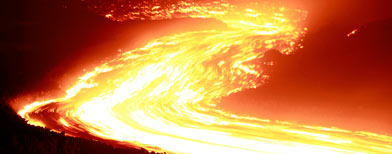Hot blobs of magma - the searing liquid rock beneath the Earth's crust - can spread slow-moving ripples that soar hundreds of meters high across the Earth's surface, a new study suggests.
This phenomenon, which works on geologic time scales, may explain relatively rapid pre-historical changes insea level that occurred without the typical waxing and waning of the polar ice sheets, which hold and release water on scales of thousands and millions of years. This unexplained sea level rise is one of geology's oldest mysteries.
During the Paleogene era (65 million to 23 million years ago), the land under Scotland moved up and down like a geological yo-yo. The surface rippled up to 1,640 feet (500 meters) over the course of only a million years - a relatively short time span, geologically-speaking.
"It appears to be caused by something deep within the Earth, moving sideways - almost like rats running underneath a carpet," said study author Bryan Lovell of the University of Cambridge.
The sideways movement is actually caused by what's known as convection currents in the mantle. These currents are created when the cooler, denser material in the mantle sinks and the warmer, less dense material rises.
"The hot blob would have spread out from the center of the hot spot rather like a doughnut," Lovell said.
A magma hot spot beneath Iceland, known as the Iceland plume, which is responsible for the Europeanisland's volcanic activity, could be behind this movement.
Data from oil exploration near the Iceland magma plume has revealed that a blob in the Earth's flowing mantle caused a pulse beneath the North Atlantic about 55 million years ago. This pulse raised and lowered the land surface and the sea floor in a rippling effect
Although scientists were confident that hot blobs exist in the mantle, evidence for the ripples at the Earth's surface have been hard to spot. While the Scotland uplift is the only example of the hot blob effect, Lovell said the movement is a natural effect of mantle convection, so there's no reason to think it isn't happening all the time, even now.
"I'm delighted that we have what appears to be a decent geophysical explanation for such a longstanding and significant geological problem," Lovell said. "I hope we'll be able to collect more observations from the geological record that will explain otherwise cryptic features of the Earth's mantle."
The study was detailed in the June 25 edition of the Journal of the Geological Society.
- Gallery: Volcanoes from Space
- Which U.S. Volcanoes Are Most Dangerous Right Now?
- 10 Wild Volcano Facts
- Original Story: Giant Magma Blobs Ripple Earth's Surface

Tidak ada komentar:
Posting Komentar